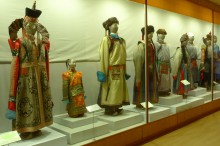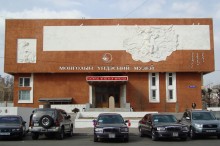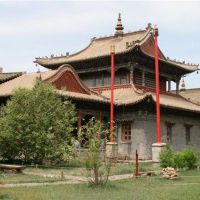National Museum of Mongolia

 The origins of the National Museum of Mongolia date back to 1924, when the first collections were begun for a national museum. The present building of the museum was built in 1971, when it was erected as the Museum of Revolution. At the time, the collections of ethnography, prehistory, middle history, national history and paleontology were housed in the building of the Central Museum, built in 1956.
In 1991, the ethnography, prehistory and middle history collections of the Central Museum were combined with 20th-century history materials at the Museum of Revolution to create the collections of the National Museum of Mongolian History. Since April 2008 the museum has been renamed as the National Museum of Mongolia.
Permanent collection: The National Museum of Mongolia is the nation's largest museum and holds a collection of over 57,000 objects relating to Central Asian history and the history of Mongolia from prehistory to the end of the 20th century, with a portion of the collected artifacts on display in ten exhibition halls. The latter include Ancient History of Mongolia; Ancient States; Traditional Clothing and Jewelry; the Mongolian Empire; Mongolian Traditional Culture; Mongolian Traditional Life; 17th-20th Century Mongolia; Mongolia 1911-1920; Socialist Mongolia (1921-1990); Democratic Mongolia (1990-present).
On average, the Museum receives around 60,000 visitors each year, of which 30,000 are foreign visitors and 30,000 are nationals, including 9000 students and 12,000 children and young people.
Education, information, outreach and similar activities have been implemented to attract visitors and raise awareness of national cultural heritage. The Museum has carried out joint projects with museums and scientific organisations from the USA, Korea, Japan, Russian Federation, Germany and China.
Since 2008, the National Museum provides all museums in the country with professional-methodological guidance and information. It has hosted conferences, held museum workshops, produced research publications in addition to exhibition catalogues. The Museum has two regular publications: 'Nomadic Heritage Studies' (research paper, published twice a year); and 'Museum News' (museum methodologies and news, published twice a year).
The Museum has a staff of 60. It is supported through admission fees and government funding from the Ministry of Culture, Sport and Tourism.
The origins of the National Museum of Mongolia date back to 1924, when the first collections were begun for a national museum. The present building of the museum was built in 1971, when it was erected as the Museum of Revolution. At the time, the collections of ethnography, prehistory, middle history, national history and paleontology were housed in the building of the Central Museum, built in 1956.
In 1991, the ethnography, prehistory and middle history collections of the Central Museum were combined with 20th-century history materials at the Museum of Revolution to create the collections of the National Museum of Mongolian History. Since April 2008 the museum has been renamed as the National Museum of Mongolia.
Permanent collection: The National Museum of Mongolia is the nation's largest museum and holds a collection of over 57,000 objects relating to Central Asian history and the history of Mongolia from prehistory to the end of the 20th century, with a portion of the collected artifacts on display in ten exhibition halls. The latter include Ancient History of Mongolia; Ancient States; Traditional Clothing and Jewelry; the Mongolian Empire; Mongolian Traditional Culture; Mongolian Traditional Life; 17th-20th Century Mongolia; Mongolia 1911-1920; Socialist Mongolia (1921-1990); Democratic Mongolia (1990-present).
On average, the Museum receives around 60,000 visitors each year, of which 30,000 are foreign visitors and 30,000 are nationals, including 9000 students and 12,000 children and young people.
Education, information, outreach and similar activities have been implemented to attract visitors and raise awareness of national cultural heritage. The Museum has carried out joint projects with museums and scientific organisations from the USA, Korea, Japan, Russian Federation, Germany and China.
Since 2008, the National Museum provides all museums in the country with professional-methodological guidance and information. It has hosted conferences, held museum workshops, produced research publications in addition to exhibition catalogues. The Museum has two regular publications: 'Nomadic Heritage Studies' (research paper, published twice a year); and 'Museum News' (museum methodologies and news, published twice a year).
The Museum has a staff of 60. It is supported through admission fees and government funding from the Ministry of Culture, Sport and Tourism.
View all Asia-Europe Museum Network (ASEMUS) members in Mongolia
Similar content
29 Jun 2016
08 Apr 2018
02 Oct 2015


